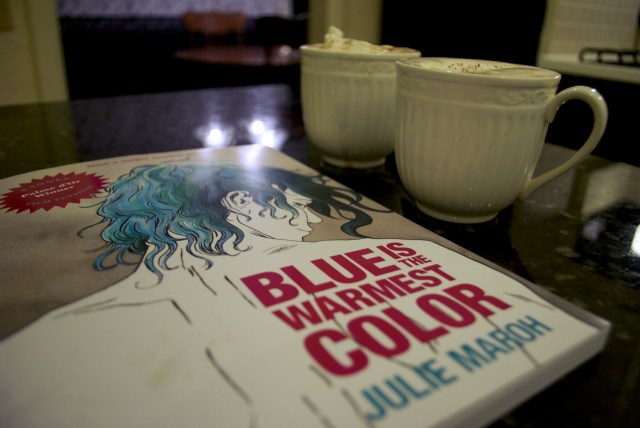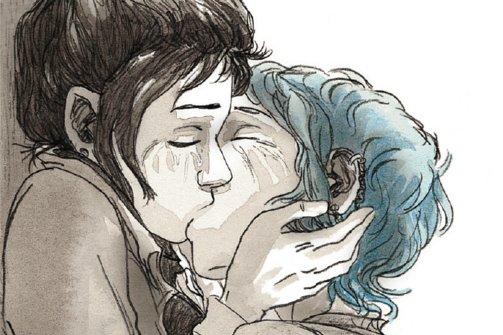We’ve taken a month and we’ve obtained Blue Is the Warmest Color by Julie Maroh. We’ve read it and drooled over the fabulous art, and we’ve probably had a lot of feelings. And you probably did all this while drinking Autostraddle’s The Warmest Drink. Now it’s time to talk about it. And we’re going to delve in quite a bit further than “did I like it or not?” But that is where we’ll start.

Warning. There will be some major spoilers. Please read on only if you’ve read it or if you don’t particularly care about spoilers.
Did we like it or not? And, of course, why?
I think for me to answer this question personally, I have to talk about it in two ways — I have to split the apart the two words that make up the term “graphic novel” and think of this first as a work of fiction and then again as an art book. As a work of fiction, I didn’t care for this book as a whole. I was really into the plot in the beginning, but after that it felt like it lost steam. Almost like a train chugging its way up a hill and the hill was just too steep for it to really succeed. We’ll talk about why I think it rolled back down the fiction-hill as we delve further into the book. But if I judge it purely on the art? This book is one of the most gorgeous I have in my collection. Which leads quite well into the next question—
How did the art further the story? Could this story have been told any other way?
Maroh illustrated it almost entirely in black and white, but in keeping with the title punctuated it with pops of color. Mostly blue! And the flash of blue, as the story went on, became inextricably linked to feelings of love and lust. And because this is essentially Clementine’s coming out experience, it almost became linked with her identity. I found that to be a smart choice on the part of the author, because on pages where there’s a ton of blue, the reader comes to expect a boatload of feelings and a much more emotionally charged portion of the story. In addition to that, the art so throughly nailed time and place that it was like reliving my costume design days. The clothing choices, particularly those of Emma and Sabine, scream “turn of the millennium dyke-tastic” and the piece of the story set in the quarter where all the gay bars are looks distinctly like the Marais (though it’s never specified). There’s no question about where we are and when we are, and I LOVE stories that do era really well.
Now, could the story have been told any other way? If you think about it, it has been. Or at least, an adaption of it. But we all know that it’s not really the same story. So looking at this independently of the Palme d’Or winning adaption, I’d say no. Now normally I call that the mark of a really solid graphic novel, like Alison Bechdel’s Fun Home. I can’t imagine the story there being told any other way, so the form and the story are so intertwined that it’s one glorious piece of art. Here though? I actually don’t find that to be a positive at all, because the reason I can’t see the story being told any other way is because there are massive holes in the plot and massive issues with the way the plot unfolds. If this were just a piece of fiction, no art included, there wouldn’t be anything present at all. Kind of like those candy bars with the air bubbles inside them. Just fluff, not really a ton of chocolate.

What do we wish could have been different in the telling of this story?
We’ll get to the plot in a hot sec, but let’s talk about the way the story was told. To map it out, we basically start with Clementine’s adolescence. During that time, she meets and falls for Emma and gets kicked out of her house because of it. Then we have a MASSIVE time jump. Massive. From her late teens to her early 30’s, with the intervening 13 years being summed up in just a few panels. And then we see Emma and Clementine fight, kinda break up, kinda get back together and then she dies. Done. When I hit that time jump, I was like, wtf? Because I felt like I had just been chugging along, reading a book, tralala, and then bam. I walked off a cliff.
Continuing that feeling into a metaphor, let’s talk about the portion of the story depicting Clementine’s adolescence as one cliff on one side of an enormous gorge. The intervening 13 years are represented by that enormous gorge. And then on the other side of the gorge there’s another cliff, and that’s Clementine’s adult years and the end of the book. Now, I am not saying that Maroh had to build is a perfect little bridge, complete and pristine, for us to walk across. I’m not saying she should patronize her readers and hold our hands every step of the way across it. Because then this graphic novel would be a graphic epic and the readers wouldn’t feel challenged to use their imagination, or to take some leaps. What Maroh did, though, is just as terrible for the reader. She gave us almost nothing to bridge that gap. So what she expected us to bring to the party was, like, the materials to build our own bridge. Or an extreme talent for jumping long distances. Or, like, one of those flying squirrel suits.

Now maybe you’ve got those things. But I didn’t. So I just fell into the gorge and was unable to climb out. Maroh lost me in that time jump.
What I wish she had done is built us some kind of thing to get us across the gap—maybe a series of floating stepping stones, or a complex rope bridge with holes in it and places to put our foot through. Enough of the plot to get us across to the other side without it being neat, tidy and unchallenging. That’s my biggest wish for the way the story was told. I wish she hadn’t lost me when she jumped through space and time faster than I could keep up.
Let’s talk about walking around your partner’s parents’ house ass-naked. Do the conflict moments in Blue is the Warmest Color feel realistic? Do they feel earned?
So the major driving conflict moment in this story, the conflict that sets all the tragedy in motion, is Clementine being ejected from her parents’ house and rejected from her family. How does that happen? Emma goes downstairs to get a glass of milk from the kitchen. And somehow, as a full-grown woman in her closeted girlfriend’s house, she thinks it is okay to do this stark naked. Like, she doesn’t foresee any consequences? It doesn’t cross her mind that maybe she should throw on some clothes? Any clothes? It’s not like Clementine’s parents don’t know she’s there, they just don’t know they’re both naked in the bed room, boning. So of course Clementine’s mom catches Emma ass-naked in the kitchen and bam, kicked out.
I’m sorry. That just doesn’t feel real or earned to me. But maybe I am wrong. Show of virtual hands, how many of y’all have walked around your partner’s parents’ house ass-naked? And keep in mind, Emma did this when Clementine’s parents were home. So only raise your virtual hand if you did this when your partner’s parents were home.
Even if a few of you say yes, I actually think this points to a book-wide issue of the conflict moments just being points to hit at any cost. There’s not really a heck of a lot of story to back them up. But not all the conflict moments. The parts where Clementine (and to some extent, Valentin) were being bullied in school were extremely real and extremely earned. This disparity lead me to do a little bit of research on Julie Maroh, and what I suspected to be true actually was—
Julie Maroh was 19 when she wrote this story. How do you see her youth affecting plot?
Now let’s look at this book a little differently. This book is damn fucking impressive now that we’re considering it was written and illustrated by a 19 year old. And as reported at this event, the story began with a competition Maroh won when she was 15. When I was 19, I would have generated conflict points that felt completely earned and completely realistic to me because I was steeped in late-teen-years hormones and everything was a conflict. I get this now.
It also explains the unrealistic quality of the portions of the book that take place in Clementine’s 30’s. Yes, authors can write things they haven’t experienced. Duh. But this very much feels like what a 19-year-old imagines a 30-year-old life to be, and without a ton of research. It explains the time jump—Maroh may not have known what to build that bridge with. And it explains the mysterious pill addiction that randomly pops up very very suddenly and leads to Clementine’s demise. And! And it explains why Clementine is mostly closeted after 13 years with the same woman. Now don’t get me wrong, there are a ton of reasons to stay in the closet, and for that long too. But what strikes me as youthful ignorance here is that a 13 year relationship could stay so static. Emma wants to be out. And in 13 years that hasn’t impacted their relationship or been a discussion or evolved at all?
It also took her five years to write the novel. Five. Years. That means she probably aged out of her own story while she was working on it—in other words, I imagine Julie Maroh got kinda sick of it. It’s only speculation, obviously. Julie Maroh doesn’t give interviews nowadays the same way she did before, so we can’t really ask her. But it would definitely explain the feeling I get of a train doggedly chugging up a hill and then just completely running out of steam. The end of the book feels rushed and uncommitted, and I’ve experienced that effect in my own writing when I get bored with my own story.

If this book were a physical space or object, what would it be?
Oh my, I’ve already called it a chugging train and a vast gorge with a cliff on either side. Ugh, now I have to come up with another physical space or object? And I made up the questions so I knew this was coming! Ah well, no take-back-sies and now let me see—I would say that Blue is the Warmest Color would be one of those ornate, gorgeous music boxes. Amazingly beautiful and fanciful, but a music box speaks mostly to youth and sentiment. And it really only does one thing—you open it and it plays music. It just does that in a really attractive way.
That said. I have a music box that I really love. So it is not impossible to love something because it is pretty and because it speaks to youth.
Why did Autostraddle choose to make The Warmest Drink the book club drink? Like, how did that relate to the story?
I thought really long and hard about the drink I created. Originally, I was going to pair Blue is the Warmest Color with a French red wine because of the book’s setting and the book’s weight on feelings of sadness—when I’m experiencing a sad story, red wine is my drink of choice. But wine felt too mature for both this book and Clementine’s relationship with Emma. It’s really a youthful story about first love and the loss of first love, and experiencing it with a drink required a few things from said drink:
1. It had to be warm and comforting. We’re reading this in winter and there’s a lot of feelings and I wanted the drink to hug you.
2. It had to harken back to youth. And nothing says youth in the winter to me like hot chocolate.
3. There had to be a bit of spice, because the story does feature sections that bite with reality. For instance, the bullying or the fact that Emma can’t access Clementine in the hospital or the uncertainty that Clementine feels about her burgeoning identity. Those small pieces of the story smacked of realism and the hard parts about being a queer woman, and they required a few drops of jalapeño bitters.
Those of you who made the drink—did you get the same things from it? Did you feel like I was hugging you in the mouth while you were reading? Because I was. In my mind.
If we were to wish up a magical book fairy that would take this book and pass it along to someone who would love it or need it, who would that person be?
I feel like this book fell into my hands too late. I’m literally the age that falls into that time jump—the age that is glossed over in the story. So when I go looking for myself in this book, it’s hard to find a reflection. But the LGBTQ community doesn’t have a lot of the young love stories in pop culture that our heterosexual counterparts have. So this book is to be commended and valued for that, even though it does play into the LGBTQ-romance-ending-in-death-trope that we so often see. I think if I could give instructions to the magical book fairy, I would deliver this to a 15-year-old lesbian who feels very uncertain in her feelings and who could use a good cry. But I would also send that same 15-year-old lesbian Mosquita Y Mari and the classic But I’m a Cheerleader (yes, book fairy, I’m asking you to bring movies too, I’m sorry) so she can see a few examples, not all of which end in pill-addicted death.
Overall?
Overall, not my very favorite. But I’m glad I read it because it’s super culturally relevant right now. And I’m glad I own it because it’s gorgeous. And I’m glad we’re talking about it because there is so much in here for discussion. I also wonder what it would have been like to read this in French—would the moments I found hollow resonate more when they aren’t translated? Because with anything translated, that’s always a possibility. Mostly what I can’t wait for is to read Julie Maroh’s next project, Skandalon. I feel like Blue is the Warmest Color is the first installment of a long and impressive career as an author and artist, and I look at it and see how Maroh is going to evolve. My prediction: it’s gonna be awesome for all of us lovers of graphic novels.
It’s time to discuss.
Let’s both agree and disagree. Let’s talk about your book feelings. Let me have it if you think I’m wrong (and I mean that! There’s no one right way to read a book). Please answer questions and ask your own in the comments below, and as with every book discussion I’ve ever lead, recognize that every read is valid and valuable. And guess what you might win for having this brilliant discussion?
We’re giving away an autographed copy of Blue is the Warmest Color to one lucky commenter!
Our own Fikri went to an event to hear Julie Maroh speak and get a couple of books signed. Maroh signed a copy just for the Autostraddle community! So how can you win it? Discuss the book in the comments below—either answer one of the questions I asked in the post, respond to another commenter, or ask (and answer!) a question of your own! Come Thursday 12/26 at 10 pm EST, I’ll pick a random comment using a number generator. But the catch is, the comment has to be about the book to win the book!
Update: And Our Winner Is…
Alaina! Not only was she randomly selected, she’s also got great things to say about reading books in translation. I highly recommend chatting with her in the comments. Congratulations, Alaina!







